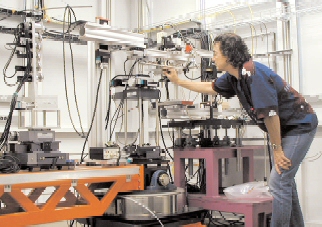The High Pressure Collaborative Access Team (HP-CAT) at APS sector 16 will be a primary location for research carried our under a new grant from the National Nuclear Security Administration (NNSA). The $5.9-million, 2.75-year NNSA grant to the Geophysical Laboratory of the Carnegie Institution in Washington, D.C., under the Stewardship Science Academic Alliances program, will fund research into the behavior of materials under extreme pressure conditions at the Carnegie/Department of Energy Alliance Center (CDAC).
The NNSA selected CDAC because of the leadership of its team in the development of new techniques and capabilities in high-pressure and high-temperature materials research. As principal investigator for the grant, Dr. Russell Hemley of Carnegie, explains: "There is a critical need to perform experiments that improve our understanding of the broad range of materials that have been used in the pursuit of national security. Our unique techniques are ideal for addressing these fundamental scientific questions. We can now subject all kinds of substances to extreme pressures and varying temperatures under strictly controlled laboratory conditions and measure changes at the atomic level. At present, we are able to reach pressures in excess of those found at the center of the Earth (3-million atmospheres) and temperatures exceeding 10,000 F (6,000 K)."
The grant will allow the scientists from the center's partner organizations to further develop their techniques; view materials as they transform from one phase to another; determine chemical reactions; relate the variables of pressure, temperature, and volume to individual materials; and much more. They will also use experimental findings to refine so-called firstprinciples models, which use information on the fundamental properties of a material to predict their behavior under an array of different conditions.
The HP-CAT facility at Argonne is a new, state-of-the-art, high-pressure synchrotron x-ray facility. HP-CAT partner organizations include Carnegie, the APS, Lawrence Livermore National Laboratory (LLNL), the University of Nevada-Las Vegas, and the University of Hawaii. Researchers will also use specialized facilities at LLNL, Los Alamos National Laboratory, and Sandia National Laboratory. To ensure the continuation of this vital research and to train the next generation of scientists in this crucial area of materials science, the CDAC will also serve as a training ground for students, postdoctoral fellows, and other investigators from around the U.S.
Using the microbeams of APS x-rays and sophisticated equipment that applies extreme pressures to a material, research groups at the APS (such as HP-CAT and GeoSoil-EnviroCARS at sector 13) can study the atoms and molecules moving in materials as pressure is increased to levels up to and beyond those found at the center of the Earth. Changes in the positions and arrangements of atoms and molecules can be measured as a function of the pressure. From these changes, researchers can understand the properties of existing materials and make new materials with new, highly desirable properties. Examples of the benefits of these studies include gaining a better understanding of the magnetic fields of the Earth and other planets; developing better cutting tools, car engines, and armor plating; helping the food industry improve sterilization processes; reaching a deeper understanding of earthquakes; gaining new information on ultra-dense hydrogen and helium to aid the development of tomorrow's clean energy sources; and exploring potential applications for the biochemical community involving studies of the dynamics of structural changes in viruses and proteins.
The physical properties of all the materials that make up our world dictate the functions of those materials. These properties (electrical, magnetic, elastic, etc.) are dictated by how atoms and molecules are arranged and attached together. For example, water is a liquid because its molecules are weakly held together; diamond is so strong because its atoms are very strongly bonded together.
When pressure is applied to a material, the atoms and molecules in that material are brought closer together. Their arrangements and the forces between them are changed, which changes the basic properties of the material. For example, squeezing hydrogen gas makes it into a liquid, a soft solid, a hard electrically insulating solid, and when its atoms are brought into extreme proximity to each other, an electrically conducting metal.
The CDAC is based at the Carnegie Institution and includes partners from Princeton University; The University of Chicago; the University of California, Berkeley; the University of Illinois at Urbana-Champaign; the University of Alabama at Birmingham; and the California Institute of Technology. The Carnegie Institution has been a pioneering force in basic scientific research since 1902. It is a private, nonprofit organization with six research departments in the U.S.: Embryology, Terrestrial Magnetism, The Observatories, Plant Biology, Global Ecology, and the Geophysical Laboratory.

